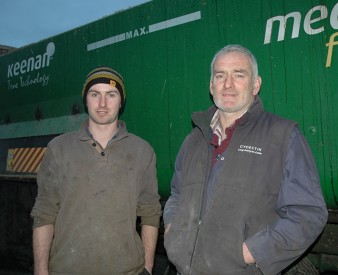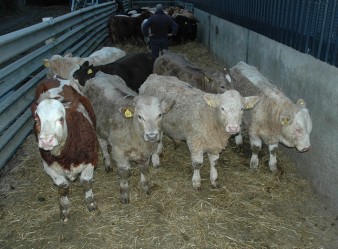Taking a strategic approach to nutrition and management
The Williams family has focused on exploiting Charolais cross efficiency for over 40 years. Taking a strategic approach to nutrition and management to beef cattle rearing and finishing is becoming increasingly important in order to achieve adequate finish and meet with processors’ 400kg to 420kg specification.
Gwythrian fact file
- Alan and Catrin Williams farming with sons Wiliam, Dafydd and Ieuan
- 780 acres including 80 acres spring barley, LFA
- 80 Continental cross cow spring calving suckler herd, put to Charolais, all progeny finished
- 420 stores bought in annually for finishing, predominantly Charolais cross heifers
- 1,300 ewes, 180% lambs reared
The Williams run a high input high output beef enterprise in order to maximise returns, not only for themselves but also to ensure their sons’ farming future – two are back on the farm and one still at college. That goes not only for the beef enterprise which they say has a firm future at Gwythrian, but also the sheep – 90% of the February born lamb crop is away finished to target weight by June.
Attention to detail is apparent as they focus on making incremental gains across all aspects of the system – from weighing a sample of cattle on a monthly basis to ensure they are achieving target gain to analysing each specifically formulated diet on a monthly basis to check for silage quality and if necessary, modify the diet.
The Williams have also implemented a grass reseeding programme; current mixes include high sugar varieties and chicory. Performance from grazed grass has improved and grass silage has become more consistent.
Alan discusses the beef system’s key features.
Suckler herd
We run a spring calving herd; 75% calve within the first two cycles and the remainder within 12 weeks; we are achieving an average 95% reared, a figure we’d like to push further. Replacement heifers are sufficiently grown to calve at two years and to an AI sire.
Maintaining a high health herd is critical; we inject for Lepto and BVD.
Charolais bulls are carefully selected within the breed’s top 10% for ease of calving and 400 day weight EBVs, however they also have to look the part. Bulls that are good on the eye and have the best Breedplan data tend to be 2,000gns above the average, however we believe they are a very good investment. With VIA already in operation at one of our processors, selecting sires for loin depth will become increasingly important.
Male calves are kept entire. Bulls and heifers are weaned at six months and housed.
Homebred bulls
On housing, the bulls are gradually introduced over a 10-day period to a high starch TMR.
We prefer to finish bulls rather than steers – we’re aware from experience they are far more efficient in terms of feed conversion, they’re easier to finish and to get the right cover and they’re all away by 13 months which frees up space for more cattle and our time for other things. For those various reasons, it’s a shame that the majority of processors are no longer interested in bulls.
Homebred heifers
We target 1.1kg DLWG from weaning to May turn out and that’s what they are achieving on Wynnstay’s diet specifically formulated for heifers. After their second grazing season they are introduced to a second diet, specifically formulated for finishing heifers – see table 2.
Purchased stores
We purchase mainly Charolais cross heifers at an average 17 months of age and 530kg at a handful of local store markets – we are very selective. We have over the years developed a relationship with various suckler men, we provide them with feedback on their cattle and encourage them to invest in Charolais bulls with the same high EBVs that we are looking for.
Housed cattle are introduced to the same finishing diet as the homebred heifers. We target 1.5kg DLG and that’s what the cattle are achieving.
50% finish off grass. They are supplemented with a mix of homegrown barley fed at 5kg a head per day and molasses for the final two months. To achieve the correct target weight and cover, we find them easier to finish off grass.
Table 1: Gwythrian beef unit performance 2015/16
|
Weaning (kg) at 24 weeks |
Target DLWG (kg) |
Finished Dwt (kg) |
Finished age (months) |
|
| Charolais cross homebred bulls |
320 |
1.7 |
390 |
13 |
| Charolais cross homebred heifers |
280-290 |
1.6 |
400 |
24 |
| Charolais cross purchased heifers |
1.5 |
400 |
24 |
Source: Gwythrian
Gwythrian nutrition: key features
Diets are all home mixed using the same basic ingredients – homegrown silage, homegrown barley and barley straw plus by-products. The diets are formulated according to age, weight and gender by Gwythrian’s nutritionist, Iwan Vaughan, of Wynnstay who offers the following pointers.
Working closely with the Williams, we have adapted diets over the years to achieve higher DLWG per kg DMI. This has meant moving away from cheaper starch based by-products to utilising more home grown barley and adding ground maize into the diet, which offers a slower fermenting starch source that reduces acid load and increases the utilisation and efficiency of the other feedstuffs.
Regularly weighing cattle along with recording feed intakes through the Keenan’s Pace software system provides valuable data and information to enable management decisions. Although the cost per kg DM of feed may be higher, the feed cost per kg of gain is far less.
Weighing cattle is key to Gwythrian’s success. The time spent doing this is nothing compared to the financial gains that can be achieved from analysing the data.
Creep feeding calves
Calves are offered concentrates as a creep feed in August to take advantage of the superior feed efficiency of a young ruminant and to restrict the check at weaning. The creep comprises 50% of a 20% protein rearer nut, and 50% oats giving us a 15% overall mix. This mix gives us higher digestible fibre from the nuts and oats which is ideally suited to be fed alongside grass. The starch within the diet is kept at a moderate level to ensure the calves are growing lean and bone at an early age and not laying down fat.
Young Bulls
After weaning the bulls are slowly introduced to a finishing diet. Starch is increased through the finishing period whilst the protein content is reduced. The target diet parameters are as follows
- MJ/kg DM-12MJ
- Crude Protein
- Starch
- Sugar
The acid load and rumen health are taken into account and faeces monitored. The diet adjusted if required.
Young Heifers
On housing after weaning they are introduced to a forage diet based on silage and supplemented with oats and a custom blend to increase energy and protein to the target levels. Starch levels are kept low through this period to encourage frame growth instead of fat deposition.
Finishing Heifers
As the finishing heifers are housed they are introduced to a grass silage diet supplemented with high levels of starch. The target parameters are as follows.
- MJ/kg DM-12MJ
- Crude Protein
- Starch
- Sugar
The target is to get as much out of the home grown silage as possible and supplement with high quality raw materials with a range of starches that degrade in the rumen over different periods of time in order to manage rumen acid loading. Faeces are monitored and diets adjusted as required.
Gwythrian diets
|
DM % |
ME/kg DM |
CP% |
FCR kg gain/kg DMI |
Main components |
|
| Bulls Seven to 13 months finish |
85 |
11.8 |
13.5-14 |
5.3:1 |
Barley, oats, ground maize, custom blend (comprising rapemeal, distillers and sugar beet pulp), molasses, minerals (including Biosprint yeast) and Sodium Bicarbonate. Straw is included in the mix, and also offered ad lib
|
| Heifers Seven to 12 months |
48 |
11.2 |
15 |
6.5:1 |
Grass silage, straw, oats, custom blend, minerals including Biosprint yeast
|
| Heifers final stage to 24 months finish |
57 |
11.8 |
13.5 |
8:1 |
Grass silage, straw, barley, oats, ground maize, custom blend, molasses, minerals (including Biosprint yeast), sodium bicarbonate
|
Source: Wynnstay
Categories: Commercial, News
Free Workshops will Highlight Role of EBVs in Bull Selection Process » « Livescot 2016


